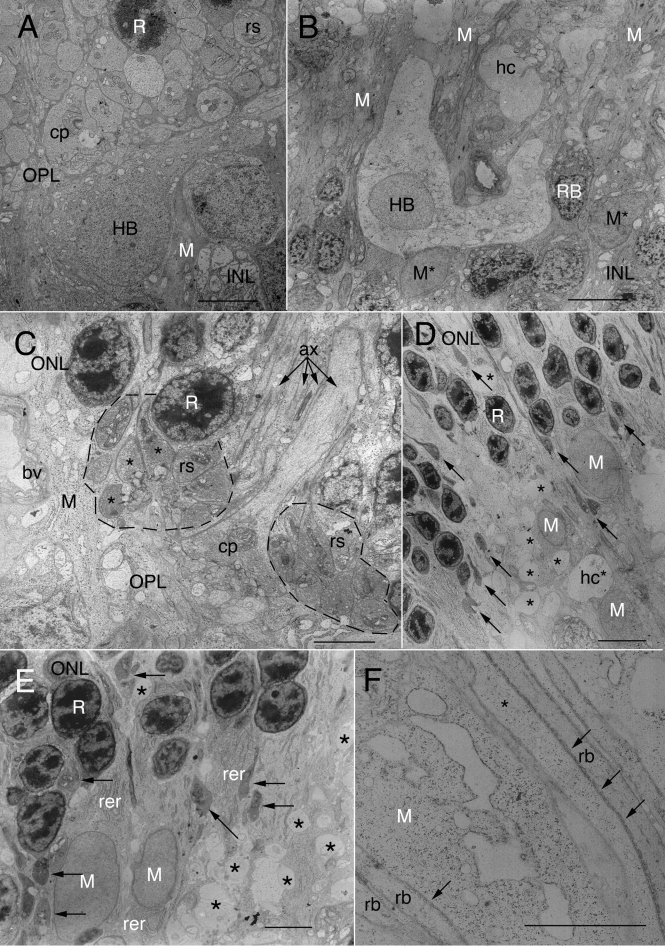Figure 3.
Electron micrographs of normal and detached cat retina. A: The cell body of a B-type horizontal cell (HB) lies at the inner edge of the outer plexiform layer (OPL). Its apical cytoplasm is densely packed with organelles. One of its main dendritic trunks courses off to the right. Many rod spherules (rs) are packed together in the outer OPL beneath the lowest tier of rod cell nuclei (R). Part of a cone pedicle is shown (cp). Dark Müller cell cytoplasm (M), though surrounding all retinal neurons, is most evident in the inner nuclear layer (INL), where Müller cell processes are thickest. Notice that Müller cell processes in the outer retina are so fine as to be unresolved between neuronal processes. Scale bar represents 10 μm. B: In cat retina detached for 7 days, HBs appear enlarged, resulting in much lighter staining of their cytoplasm and a decreased density of organelles. Similar lightly-stained and enlarged profiles (hc) occur throughout the OPL. These correspond to the ‘vacuoles’ in the OPL of Figure 1B,C,E-G. The OPL is disrupted lacking the typical layering of photoreceptor terminals. Müller cell cytoplasm (M) is atypically obvious in the outer OPL. Müller cell nuclei in the INL (M*) are less electron dense than usual and have rounded up, losing their typical angularity. Electron dense RB somata lie to either side of the HC, one of which is labeled. Scale bar represents 10 μm. C: In 7-day detached cat retina, 2 clusters (dotted outlines) of rod spherules (rs) are in their usual position above the OPL neuropil, surrounding a cone pedicle (cp). Those at the left have turned their basal synaptic surfaces toward one another; 3 of them have no hilus but have apparent postsynaptic contacts in non-invaginating or “open” configurations. (See also Figure 4C.) On the far left, a thick column of Müller cell cytoplasm has replaced lost photoreceptor terminals. The axons of rods and cones (ax) are indicated by arrows. Scale bar indicates 5 μm. D: Ectopic Müller cell nuclei (M) lie in the proximal ONL and OPL of 7-day detached retina. Their processes are clearly evident in the ONL where they surround surviving rod nuclei (R). Swollen HC processes (*) and dendrites (hc*) are evident deep in the ONL as well as the OPL. Electron-dense, teardrop-shaped retracting spherules (arrows) and their axons lie at varying levels in the proximal ONL. The OPL is largely filled with HC and Müller cell processes. Scale bar represents 10 μm. E: The outer OPL in a 7-day detached retina contains darkly-stained, elongated rod spherules (arrows) that are seen at the OPL and also within the proximal ONL amid rod nuclei (R). Large Müller cell nuclei (M) lie within the OPL in columns of cytoplasm that often contain extensive arrays of rough endoplasmic reticulum (rer), scattered mitochondria, polysomes, and cytoskeletal elements. Asterisks indicate swollen HC processes. Scale bar represents 5 μm. F: In 7-day detached retina, thickened rod bipolar cell dendrites (rb) and a cone axon (*) co-fasciculate through the inner ONL with a stout Müller cell process containing distended rER and many ribosomes. Subsurface cross-sections of smooth endoplasmic reticulum (arrowheads) are part of the “helical organelle” characteristic of rod bipolar cells and key to their identification by electron microscopy. Scale bar represents 5 μm.

